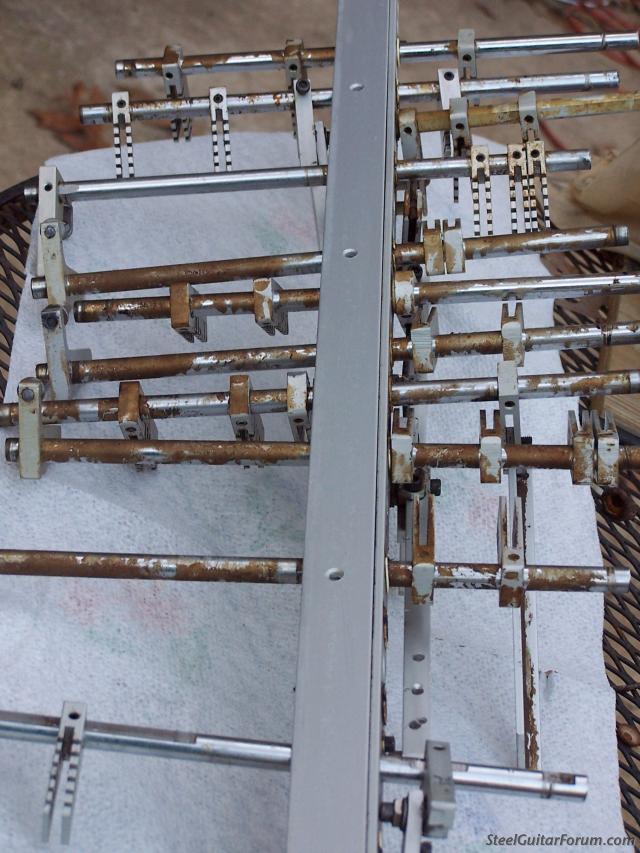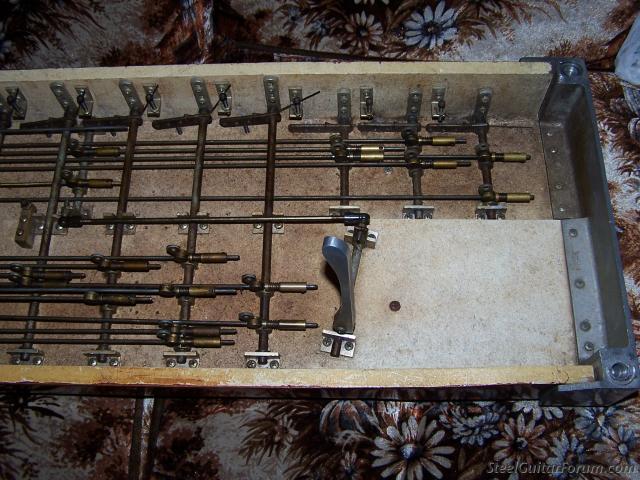Page 1 of 2
WD40 pics and ???? hope all that use it checks this out
Posted: 3 Mar 2008 8:58 am
by Tommy Young
what would you use to clean this wd40 mess the brown is
the wd40 for those that couldn't figure it outhaha

So far I have been using carb. cleaner and brake parts cleaner,paint thinner,parts solvent any other suggestions this is a h%$$ of a mess the whole underside is this way and just gotten thru going thru the changers on this baby my hands are tired???
TOMMY YOUNG
MAX-TONE MODIFICATIONS
Posted: 3 Mar 2008 9:04 am
by John Roche
Steel Wool
Posted: 3 Mar 2008 9:25 am
by Ricky Newman
More WD40
...then dishsoap and water
then a cloth and a hairdryer
then 3-in-1
Posted: 3 Mar 2008 9:59 am
by Ken Byng
It just shows that WD40 has its place, but it's not on a pedal steel guitar.
I would use a degreaser solvent with a nylon bristle washing up brush. Then use a fine sewing machine oil or Tri-Flow.
KB
Posted: 3 Mar 2008 10:01 am
by James Morehead
Mother's will clean it right up and put a real nice shine on those parts. Use a toothe brush. Be sure to clean the toothe brush up before you give it back to your wife, though.

Here's a nasty oversprayed WD40/tobacco all over the cabinet mess---yuck! Livin' proof why not to use WD 40.


Posted: 3 Mar 2008 10:44 am
by Lee Baucum
Tommy - Is that rust?
James - I rebuilt a S-12 MSA years ago that looked just like that. Years and years of WD-40 and nicotine buildup. I used WD-40 to cut all the muck and then used Windex to clean the loosened muck off the parts. Wiped everything clean with dry cloth and rebuilt it, using teflon (Tri-Flow) for lubricant.
Lee, from South Texas
Posted: 3 Mar 2008 10:51 am
by James Morehead
Hey Lee, Right you are, these guitars looks sooooo good once they are cleaned up.
Posted: 3 Mar 2008 11:26 am
by Mike Mantey
All you need is lacquer thinner.
Use real carb cleaner.
Posted: 3 Mar 2008 11:26 am
by Bill A. Moore
I'm in the auto repair business, longer than some would admit, and still rebuild those old things that atomize fuel into the engine. I keep a 5 gal. bucket of cleaner which is not the stuff you get in a spray can. It attacks petroleum based crud like in your picture, and washes off with water. If you have an automotive machine shop close, they often use the same solution to clean their aluminum parts. It also will not affect the nylon bushings, (if there are any). Good luck, Bill.[/b]
Posted: 3 Mar 2008 11:49 am
by John Roche
Trichoethylene would work...
Posted: 3 Mar 2008 12:27 pm
by basilh
John Roche wrote:Trichlorethylene would work...
Yep.. Not to be sniffed at !!
Posted: 3 Mar 2008 2:00 pm
by Jerry Roller
Lacquer thinner can't be beat.
Jerry
Posted: 3 Mar 2008 3:09 pm
by A. J. Schobert
Tommy that looks like rust, I find it hard to believe that wd40 did that, I would use wd40 to help keep my hand tools in good shape,I do know not to use wd40 as a lubricant on the PSG, however I would try to use steel wool. Maybe some type of abrassive cleener on a drill? Maybe replacement?
Later
Posted: 3 Mar 2008 3:46 pm
by Darvin Willhoite
Looks like rust to me too. I don't see any corrosion on the ends of the shafts where the WD40 would have been used for lubrication. Why would anyone spray it on the shafts where there was no contact with other parts?
Posted: 3 Mar 2008 5:21 pm
by Bill Cutright
CLR will work.
Posted: 3 Mar 2008 5:53 pm
by Ron !
And if all this good advice fails.Then there is always this.

Posted: 3 Mar 2008 5:54 pm
by Mark MacKenzie
Any auto shop should have a tank they clean parts in. Aviation mechanics use something called Varsol. Just let it soak in the tank and maybe brush it off. All that crud would come off in seconds, I bet. If I had to do it at home, I would use mineral spirits.
Posted: 3 Mar 2008 6:16 pm
by Jerry Roller
I believe that stuff is dried on nicotine. The cross shafts are chromed and the pull rods are stainless so it should not be rust. I am currently rebuilding a '70 push pull and it was in that shape. I soaked the undercarriage parts in a heavy duty concentrated cleaner from Lowes and it did pretty well. Lacquer thinner is the quickest and best I have found. On one, I bought a gallon of carb cleaner and it worked well. I poured it back in the can and in a year it ate a hole in the gallon can and leaked all out in our storage building. I think that stuff is dangerous to handle or breathe.
Jerry
Posted: 3 Mar 2008 6:29 pm
by James Morehead
A. J. Schobert wrote:Tommy that looks like rust, I find it hard to believe that wd40 did that, I would use wd40 to help keep my hand tools in good shape,I do know not to use wd40 as a lubricant on the PSG, however I would try to use steel wool. Maybe some type of abrassive cleener on a drill? Maybe replacement?
Later
First time I've ever seen aluminum parts rust, then.
Some Mothers backed up with a little elbo grease. Or carburator cleaner will disolve it mille seconds. Replacement? Naw.
Posted: 3 Mar 2008 7:14 pm
by Chris LeDrew
Ron ! wrote:And if all this good advice fails.Then there is always this.

Ha-ha.....the flamethrower always has the last word.
Posted: 3 Mar 2008 7:44 pm
by Alan Brookes
Trichlorethylene is an obnoxious, poisonous liquid. We model railroaders used it for years to clean track. No-one ever told us that it eats your lungs away.

Posted: 3 Mar 2008 8:09 pm
by A. J. Schobert
James M. yes you are right Aluminum doesn't rust, but it does corrode, yes rust is in referrence to iron or steel, which is what I thought the metal was at first, it may be steel.
Since it is redish color that is how I came up with my statement. I find it hard to believe that wd40 did this when I use it so many times on different things around the house and never have a problem, also I wouldn't think wd40 would oxidize alumiunum, maybe it did.
I like the above statement to take it to a body shop and have it sand blasted, I would guess it would have to be rechromed, but it would anyway right.
Take Care
Posted: 3 Mar 2008 8:42 pm
by Steve English
Most definitely not rust, and certainly no oxidation visible. My educated guess is Tommy Young knows exactly what it is.
That stuff will clean right off. I'd stick with the carb and brake cleaners.
Posted: 4 Mar 2008 5:22 am
by Jim Sliff
A couple comments regarding ideas posted:
1. Following cleanup with 3-in-1 is just creating a new dirt magnet. 3-in-1 and other oils ATTRACT dirt - which will mack things sticky, slow and grungy. Keep oil away from your guitars.
2. DON'T use lacquer thinner on an assembled guitar. The solvents will attack formica and do permanent damage to lacquer finishes (it re-wets lacquer, which will essentially melt and run). You could use it to soak removed parts, but it also leaves a residue and is not a great idea.
3. Don't use trichloethylone. Chlorinated solvents are extremely dangerous to the respiratory system. Read the MSDS and pay attention.
4. The best method (IMO) would be removing everything and soaking in MEK (in a safe environment and using gloves, goggles and a respirator) for about a week...still might need scrubbing. Anything you do ON the guitar will just get some of the WD40 residue into moving parts.
5. No matter WHAT solvent you use - and you will need a solvent - follow safety precautions, especially fire, respiratory and eye protection.
6. This is another in a never-ending series of examples of why WD40 should never go near a guitar, ever. Or much of anything else, other than garage door springs.
TY
Posted: 4 Mar 2008 5:26 am
by Billy Carr
That reminds me why I don't rebuild guitars. Minor adjustments and set ups only on those I sell or trade on. TY knows his stuff. Whatever it is will be showroom ready when he's finished. If he puts a MOD on it, lookout! See you in Fulton, TY!



